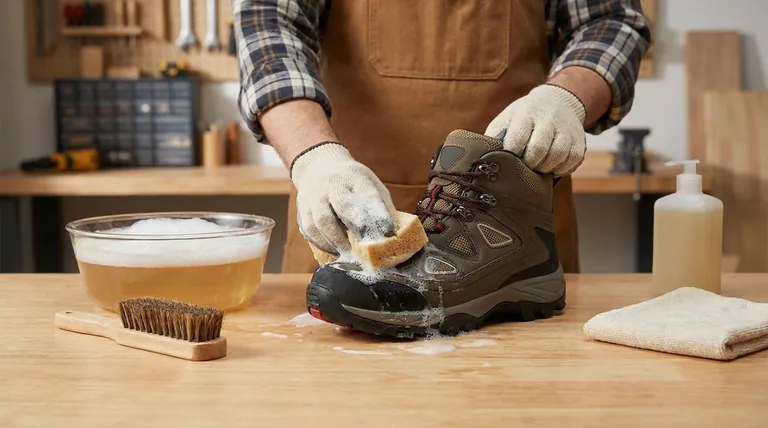The most recommended method for cleaning textile or synthetic work shoes, such as those made from microfibre or mesh, is a manual approach. You should use a simple solution of warm water and mild soap, applied gently with a soft sponge to lift dirt without damaging the shoe's delicate materials.
The core principle is to use a gentle, controlled cleaning process. This preserves the structural integrity and technical properties of synthetic fabrics, which can be easily damaged by aggressive washing methods or harsh chemicals.

The Step-by-Step Cleaning Protocol
Proper cleaning is about more than just removing dirt; it's about maintaining the performance and lifespan of your footwear. Following a precise method prevents material degradation.
Preparing the Shoes
Before you begin, remove the laces and any removable insoles. This allows you to clean these components separately and gives you better access to the inside of the shoe.
Creating the Right Solution
Mix a small amount of mild soap or detergent with warm water. Avoid using harsh chemicals, bleach, or abrasive cleaners, as they can break down the synthetic fibers and adhesives used in modern shoe construction.
The Gentle Application
Dip a soft sponge or cloth into the soapy water. Gently scrub the surface of the shoes in small, circular motions. The goal is to lift the dirt from the fabric, not to grind it in. A soft brush, like an old toothbrush, can be used for stubborn spots or textured areas like mesh.
Rinsing and Air-Drying
Wipe the shoes down with a separate, clean cloth dampened with plain water to remove any soap residue. Stuff the shoes with paper towels or newspaper to absorb internal moisture and help them hold their shape.
Crucially, let them air-dry at room temperature. Never place them near a direct heat source.
Common Pitfalls to Avoid
The wrong cleaning techniques can cause more harm than the dirt itself. Understanding what to avoid is as important as knowing what to do.
The Damage from Machine Washing
While tempting, using a washing machine is highly discouraged. The combination of prolonged water submersion, tumbling action, and high heat can weaken glues, deform the shoe's structure, and damage the textile uppers.
The Risk of Harsh Chemicals
Strong detergents and solvents can strip synthetic materials of their coatings and colors. This can lead to discoloration, brittleness, and a significant reduction in the material's durability.
The Problem with Direct Heat
Never use a hairdryer, radiator, or direct sunlight to speed up the drying process. Intense heat can warp the synthetic materials, melt adhesives, and cause the sole to separate from the upper, permanently ruining the footwear.
How to Apply This to Your Goal
Your cleaning approach may vary slightly depending on the situation.
- If your primary focus is routine maintenance: A quick wipe-down with a damp sponge and mild soap solution after use is sufficient to prevent dirt buildup.
- If your primary focus is removing a stubborn stain: Use a soft-bristled brush on the specific spot with your cleaning solution, and allow the solution to sit for a few minutes before gently scrubbing.
Proper care and gentle cleaning are the keys to extending the effective life of your work shoes.
Summary Table:
| Step | Action | Key Tool/Material | Important Note |
|---|---|---|---|
| 1. Preparation | Remove laces and insoles | - | Allows for thorough cleaning |
| 2. Solution | Mix mild soap with warm water | Mild soap, Warm water | Avoid harsh chemicals and bleach |
| 3. Cleaning | Gently scrub in circular motions | Soft sponge or cloth | Use a soft brush for stubborn spots |
| 4. Rinsing | Wipe with clean, water-dampened cloth | Clean cloth | Remove all soap residue |
| 5. Drying | Air-dry at room temperature | Paper towels/newspaper | Never use direct heat sources |
Looking for Durable, Easy-to-Maintain Work Footwear?
As a large-scale manufacturer, 3515 produces a comprehensive range of high-performance work shoes and boots for distributors, brand owners, and bulk clients. Our footwear is designed with durability and easy maintenance in mind, using quality materials that stand up to the demands of the job while being simple to care for.
Let us help you equip your workforce with reliable footwear.
Contact us today to discuss your needs and explore our extensive catalog.
Visual Guide

Related Products
- Safety Footwear Wholesale Manufacturer for Custom OEM/ODM Production
- Premium Flame-Retardant Waterproof Safety Boots and Shoes
- Premium KPU Injection Athletic Style Safety Shoes
- Wholesale Lightweight Tactical Boots with Dial Closure OEM & Bulk Orders
- Premium Wholesale Tactical Style Safety Shoes Boots with Quick Lacing
People Also Ask
- Is it normal to wear shoes in the house? A Guide to Hygiene, Comfort & Culture
- Is safety-toe as good as steel toe? Choose the Right Protection for Your Job
- What are OSHA approved shoes? Understanding the Correct Standards for Workplace Safety
- How long can you wear safety boots? The Lifespan is Determined by Wear, Not Time
- What are the cultural perspectives on wearing shoes in the house? A Guide to Home Etiquette & Hygiene



















